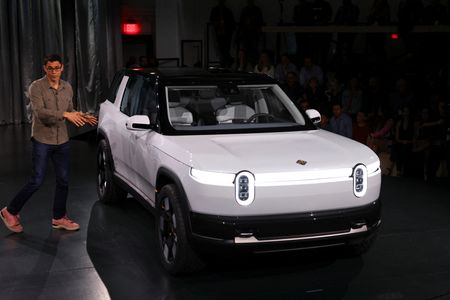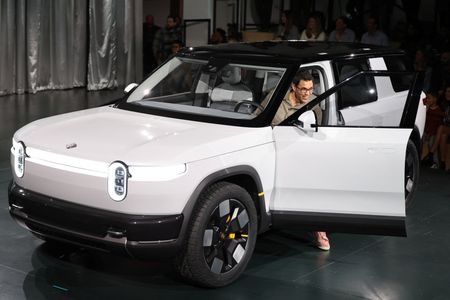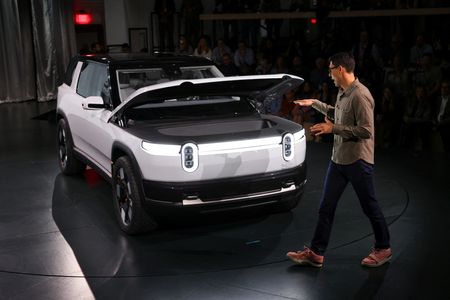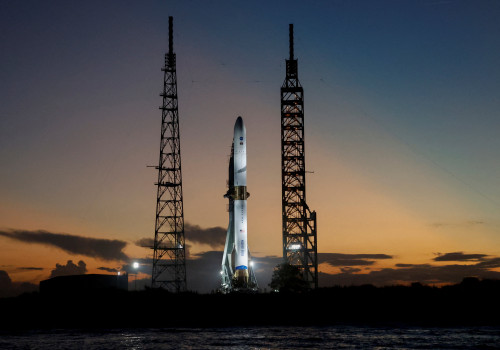By Chris Kirkham and Abhirup Roy
LAGUNA BEACH, California (Reuters) -Rivian on Thursday introduced its smaller, less expensive electric R2 SUVs and R3 crossovers with plans to start producing the R2 at its existing U.S. factory to hasten deliveries in the first half of 2026.
Rivian shares closed up 13.4% at $12.51 after the company said its new strategy would help save more than $2 billion.
The R2’s starting price of $45,000 is well below the company’s flagship R1 SUVs and pickups. The new vehicle is seen as critical to Rivian’s success amid a sharp slowdown in EV demand due to high interest rates. Electric vehicles are typically more expensive than gasoline-powered cars.
Rivian had previously planned to launch the R2 – a five-seater version of the automaker’s larger R1S SUV with more than 300 miles (483 km) of range – at a planned $5 billion plant in Georgia.
But some analysts have questioned the need for building the factory.
Rivian had previously said that the R2 would launch in 2026, without elaborating, but on Thursday it said that by starting production in Normal, Illinois, it was accelerating its timeline to the first half of that year.
“We’re able to achieve that accelerated timing by leveraging our production capabilities in Normal, using our Illinois site to launch R2 and get that into market as quickly as we can,” CEO RJ Scaringe said.
Rivian investor Vitaly Golumb said: “This certainly takes some pressure off the continued massive cash investment needed for the Georgia plant. I would also hope that they are being conservative and will be able to pull forward the delivery dates even further.”
Rivian said it had sufficient capital to fund operations through the launch of the R2.
‘SLOW THE BURN’
Still, expanding production in Normal and building the Georgia plant will be expensive. Rivian raised more than $3 billion with two bond issuances last year and has just over $9 billion in cash, but some analysts and investors say it will need additional capital by 2026.
“They need to get positive cash and currently they’re bleeding money. Even though they have billions in reserve, that will go quickly when you’re losing $40,000 a vehicle,” said Sam Fiorani, vice president of global vehicle forecasting at AutoForecast Solutions.
“If R2 is as profitable as Rivian wants it to be, it could go a long way to help slow the burn of cash.”
The Illinois plant, where Rivian also makes its electric delivery vans, can produce 150,000 vehicles a year, a Rivian spokesperson said. With the addition of the R2, Rivian said it expected total annual capacity there of 215,000 vehicles.
Construction would resume later in Georgia as that site “remains an extremely important part of its long-term strategy,” Rivian said.
Rivian produced 57,232 vehicles last year and said growth this year would be flat as it tackles slowing demand and production downtime to make upgrades intended to cut costs and improve margins.
Despite the immense popularity of SUVs and pickups in the United States, ramping up production and generating demand beyond the initial wave of enthusiasts has been an uphill battle.
Offering affordable EVs at scale is seen as key to attracting customers still unwilling to switch over from their cheaper gas-guzzling vehicles.
In a surprise move, Rivian also introduced the R3 and a more powerful R3X variant on Thursday. The R3 will cost less than the R2 and be launched after that vehicle. Rivian did not disclose any other details.
AutoForecast’s Fiorani said his firm had forecast the R3 launching in 2028, but he said in light of Thursday’s announcement, production could now start in 2027 and the vehicle could be priced between $40,000 and $45,000. The R3 and R2 are built off the same platform and it should be relatively easy to roll out one after the other, he said.
Excitement was high at the launch event at a packed , historic movie theater that Rivian restored in Laguna Beach, just across the street from the Pacific Ocean.
Jimmie Smeath, 39, and Joshua Jarvis, 33, came in from the Salt Lake City, Utah, area after the company invited them. Both own R1 vehicles and regularly use them for camping, snowboarding and mountain biking.
“It’s Rivian’s way forward,” Jarvis said. “This is obviously huge for the company, just because it is a better price point. The R2, starting at $45,000? That’s insane for an EV.”
(Reporting by Chris Kirkham in Laguna Beach, California, and Abhirup Roy in San FranciscoAdditional reporting by Zaheer Kachwala in Bengaluru and Ben Klayman in DetroitEditing by Lisa Shumaker and Matthew Lewis)









